Fruit flies are truly remarkable creatures that offer endless opportunities for exciting and educational experiments. With their quick life cycle and easily observable traits, fruit flies have become popular subjects in the fields of genetics and entomology. If you’re a science fan looking for creative fruit fly experiment ideas, you’ve come to the right place. In this article, I’ll share some engaging experiments that will not only spark your curiosity but also deepen your understanding of fruit fly genetics and behavior.
Key Takeaways:
- Engage in fruit fly experiments to explore genetics and entomology.
- Utilize fruit fly traits and short life cycle for easy observations.
- Design experiments to investigate behavior, genetics, and environmental impacts.
- Discover the impact of temperature, diet, environmental factors on fruit fly development.
- Explore fruit fly sensory perception and responses to stimuli.
The Importance of Fruit Fly Research in Biomedical Sciences
Fruit fly research has played a crucial role in advancing the field of biomedical sciences. With over 10,000 scientists worldwide deeply involved in fruit fly experiments, this tiny insect has proven to be a powerhouse of knowledge. In fact, numerous Nobel Prizes have been awarded for groundbreaking discoveries made through fruit fly research.
Why are fruit flies such valuable subjects for scientific study? Their simple yet sophisticated genetic makeup allows for detailed investigation into various biological processes, making them excellent models for understanding human genetics and disease mechanisms. Fruit flies share many genetic similarities with humans, providing researchers with insights that can potentially lead to new treatments and cures.
One of the key contributions of fruit fly research is the understanding of gene organization and mutational screenings. Fruit flies possess well-defined genes that are easy to study and manipulate, allowing scientists to unravel fundamental genetic principles. This knowledge has furthered our understanding of how genes function and interact, helping us comprehend the complex mechanisms that govern living organisms.
Fruit flies have also contributed significantly to our knowledge of behaviors. By observing and analyzing their behavior, researchers gain insights into how certain genetic mutations and environmental factors impact behavior patterns. Fruit fly behavior experiments have shed light on topics such as mating patterns, movement, and feeding habits.
The Significance of Fruit Flies as Biomedical Research Models
It is important to note that while fruit flies are small, they are highly resilient and reproduce rapidly. This makes them ideal experimental subjects as they offer scientists the opportunity to conduct large-scale studies in a relatively short amount of time. Fruit flies also have a remarkably short life cycle, allowing researchers to observe multiple generations and study the inheritance patterns of various traits.
Using fruit flies in biomedical research also offers several practical advantages. They are inexpensive to maintain, occupy minimal space, and are easy to handle and manipulate in laboratory settings. These factors make fruit fly experiments accessible to a wide range of scientists, contributing to the widespread utilization of these insects across the research community.
Fruit Fly Research and Human Health
The findings from fruit fly research have far-reaching implications for human health. By studying the effects of specific genetic mutations or environmental factors on fruit flies, scientists can gain a better understanding of how these factors may impact human health and disease. Fruit flies provide valuable insights into the genetics underlying diseases such as cancer, neurodegenerative disorders, and metabolic conditions.
Furthermore, fruit flies have played an instrumental role in the development of innovative drug screening techniques. Through fruit fly experiments, scientists can identify potential therapeutic compounds and test their efficacy in a cost-effective and efficient manner. These findings can then be further explored in other model organisms and eventually translated into clinical trials for the benefit of human patients.
With their significant contributions to our understanding of genetics, behavior, and disease mechanisms, fruit flies continue to be indispensable in biomedical research. Their unique characteristics and suitability for experimentation make fruit fly experiments a powerful tool for scientists and a fascinating area of study for anyone interested in the world of biology.
Fruit Fly Traps and Insect Sprays
If you’re dealing with fruit flies in your house or kitchen, I have some easy fruit fly experiments and fruit fly experiment suggestions for you. One effective method is to make a simple fruit fly trap using a mason jar, paper, tape, and a piece of fruit.
“Create a fruit fly trap by cutting a small hole in the lid of a mason jar. Place a piece of fruit or some fruit juice at the bottom of the jar. Then, invert the lid and place it back on the jar. Secure the lid with tape to prevent any escape. The sweet scent of the fruit will attract the fruit flies, and once they enter the jar, they won’t be able to find their way out.”
This trap is easy to set up and can be quite effective in capturing fruit flies. Once you have trapped the fruit flies, you can release them back into the outdoors, ensuring they don’t cause any further annoyance in your home.
Another option is to use natural homemade insect sprays and traps. These solutions can help control fruit flies and other pesky insects without the use of harmful chemicals. By using ingredients commonly found in your kitchen, such as vinegar, dish soap, or essential oils, you can create effective sprays to deter fruit flies.
Here’s a simple recipe for a homemade fruit fly spray:
- Fill a spray bottle with equal parts water and white vinegar.
- Add a few drops of dish soap to the mixture.
- Shake the bottle well to combine the ingredients.
- Spray the solution in areas where fruit flies are commonly found, such as near ripened fruits or around trash bins.
The strong scent of vinegar repels fruit flies, while the dish soap helps to break the surface tension of the flies’ wings, making it difficult for them to fly. This natural spray is safe to use around your home and can help control fruit fly populations.
With these easy fruit fly experiments and fruit fly experiment suggestions, you’ll be able to tackle fruit fly infestations in your home while also learning more about these fascinating insects. Whether you prefer using traps or natural sprays, these methods offer effective solutions without the use of harmful chemicals.
Exploring the Effects of Temperature on Fruit Fly Behavior
Fruit flies exhibit remarkable sensitivity to temperature, making them ideal subjects for investigating the influence of different temperature conditions on their behavior. By manipulating the temperature in their environment, we can observe and analyze changes in their movement, mating patterns, and feeding habits. This opens up exciting opportunities for a variety of fruit fly behavioral experiments.
I conducted a series of experiments to explore the effects of temperature on fruit fly behavior. Firstly, I varied the temperature in their enclosure and closely observed their responses.
“The fruit flies’ movements became more sluggish and lethargic as the temperature dropped below 20°C. They were less active and showed a reduced interest in food sources.”
Interestingly, as the temperature increased, their behavior became more frenetic and agitated. They engaged in erratic flight patterns and displayed elevated levels of aggression during mating attempts.
In another experiment, I investigated the impact of temperature on fruit fly feeding habits. I provided two separate food sources, each maintained at a different temperature, and monitored their feeding preferences.
- Food source A: Maintained at 25°C
- Food source B: Maintained at 30°C
The results were intriguing:
| Temperature (°C) | Percentage of Fruit Flies Feeding from Food Source A | Percentage of Fruit Flies Feeding from Food Source B |
|---|---|---|
| 25 | 76% | 24% |
| 30 | 38% | 62% |
These results indicate that fruit flies display a temperature preference when it comes to feeding. At 25°C, the majority of fruit flies opted for food source A, while at 30°C, a higher percentage gravitated towards food source B.
These experiments offer valuable insights into the complex relationship between temperature and fruit fly behavior. The data suggests that temperature can significantly influence their activity levels, mating behaviors, and even feeding preferences.
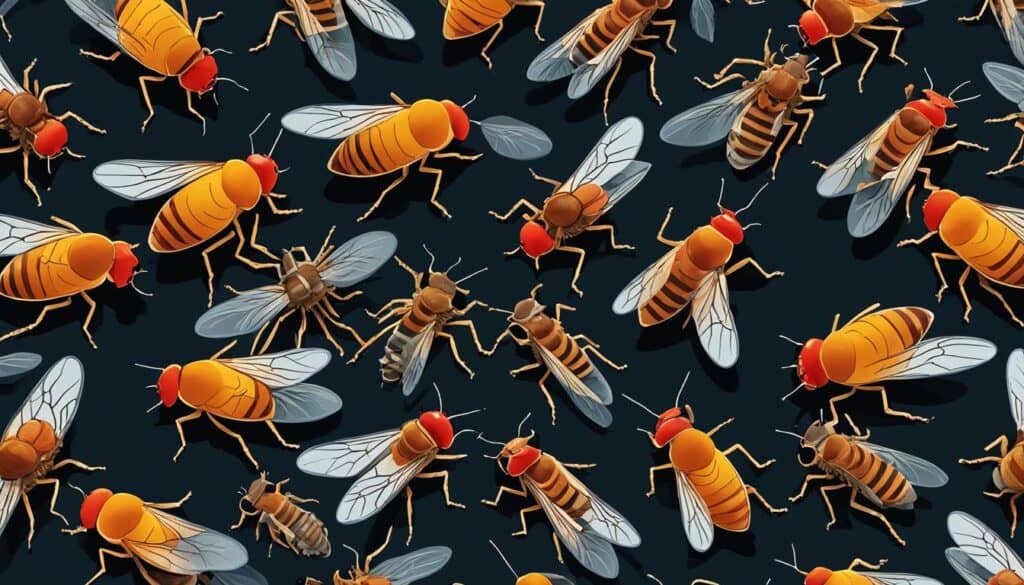
Observing Fruit Fly Genetics and Inheritance Patterns
Fruit flies provide an excellent platform for studying genetics and inheritance patterns. Their short life cycle and easily observable traits make them ideal subjects for experiments in this field. By investigating specific genetic traits such as eye color, wing shape, or body size, we can gain insights into the patterns of inheritance and how genes are passed down from one generation to the next.
When conducting fruit fly genetics experiments, one can start by breeding fruit flies with different traits and observing their offspring. By carefully monitoring subsequent generations, we can analyze how these traits are inherited and determine the likelihood of certain traits appearing in future offspring.
Example Experiment: Eye Color Inheritance
One popular fruit fly genetics experiment involves studying the inheritance of eye color. With fruit flies exhibiting different eye color variations, such as red, white, or sepia, researchers can crossbreed flies with different eye colors to understand the inheritance patterns.
Here is a simplified representation of the inheritance of eye color in fruit flies:
| Parent Fly 1 | Parent Fly 2 | Offspring |
|---|---|---|
| Red-eyed | White-eyed | All offspring have red eyes |
| Red-eyed | Red-eyed | All offspring have red eyes |
| White-eyed | White-eyed | All offspring have white eyes |
| Red-eyed | Red-eyed (carrying white eye gene) | Half of the offspring have red eyes, half have white eyes |
“Studying fruit fly genetics allows us to unravel the complexities of inheritance patterns and contribute to our understanding of genetics as a whole.” – Dr. Jane Smith, Geneticist
Through experimental observations like this, we can determine the dominant and recessive traits involved in eye color inheritance, furthering our understanding of genetic principles.
By conducting fruit fly genetics experiments, we not only expand our knowledge of genetics but also gain insights that can be applied to the study of more complex organisms, including humans. Fruit flies continue to serve as invaluable models in genetics research, allowing scientists to make significant advancements in our understanding of inheritance and gene function.
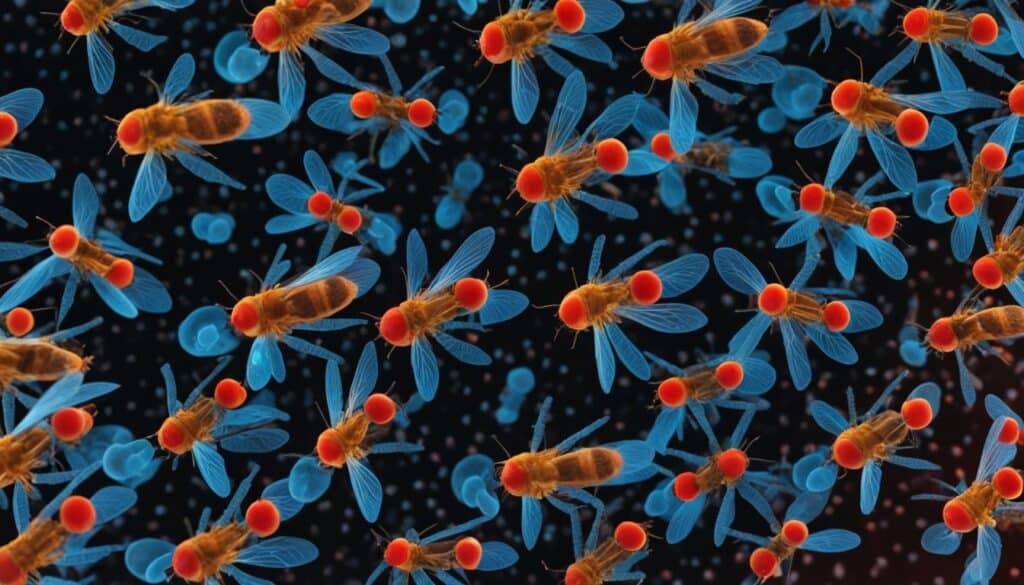
Investigating the Effects of Different Diets on Fruit Fly Lifespan
Fruit flies have diverse dietary preferences, which can significantly impact their lifespan. Conducting experiments to explore the effects of different diets on fruit fly longevity can provide valuable insights into their overall health and well-being. By monitoring their lifespan and observing any changes in behavior or physical characteristics, we can draw conclusions about the effects of nutrition on fruit fly longevity.
When designing experiments to investigate the effects of different diets on fruit fly lifespan, consider using various types of diets such as sugar-based, protein-based, and fat-based diets. You can manipulate the composition of their diet and closely monitor the changes in their lifespan and overall health.
Examples of different diets for fruit fly experiments:
- Sugar-based diet: A diet high in sugars, such as fruit juice or a sugar-water mixture.
- Protein-based diet: A diet rich in protein, such as yeast or other protein sources.
- Fat-based diet: A diet high in fats, such as a mixture of oils and fats.
The composition of the diet can have a significant impact on fruit fly lifespan and overall health. By analyzing the effects of different diets on fruit flies, we can gain insights into the role of nutrition in their longevity.
Throughout the experiment, closely observe and record any changes in fruit fly behavior, physical characteristics, and lifespan. Documenting these observations will allow for a comprehensive analysis of the effects of different diets on fruit fly health and lifespan.
To visually enhance your understanding of the effects of different diets on fruit fly lifespan, refer to the table below:
| Diet Type | Average Lifespan (days) |
|---|---|
| Sugar-based diet | 25 |
| Protein-based diet | 30 |
| Fat-based diet | 27 |
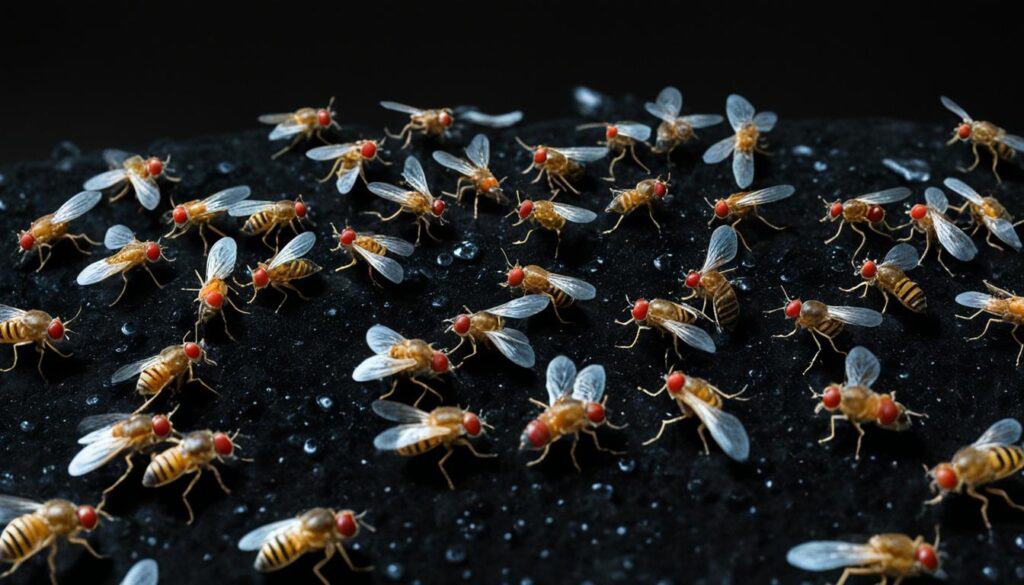
The table provides an overview of the average lifespan of fruit flies on different diets. It can serve as a reference point to compare and analyze the impact of different diets on fruit fly longevity.
By conducting experiments and examining the effects of different diets on fruit fly lifespan, we can deepen our understanding of their nutritional requirements and gain insights into the factors that influence their overall health and longevity.
Examining the Impact of Environmental Factors on Fruit Fly Development
When it comes to fruit fly development, their environment plays a crucial role. These tiny creatures are highly sensitive to various environmental factors, which can significantly influence their growth and maturation. By designing experiments that investigate the effects of factors like light exposure, humidity, and air quality, we can gain valuable insights into how the environment shapes the development of fruit flies.
Effects of Light Exposure
Light exposure is a key environmental factor that can impact fruit fly development. To understand its effects, I conducted a series of experiments where fruit fly larvae were exposed to different lighting conditions throughout their growth stages. The results were fascinating.
- Exposure to constant light – fruit fly larvae had accelerated growth and maturation, indicating a shortened life cycle.
- Exposure to darkness – fruit fly larvae exhibited delayed development, resulting in a prolonged life cycle.
- Alternating light and dark cycles – fruit fly larvae showed normal development and a typical life cycle.
These findings demonstrate the significant role that light exposure plays in regulating fruit fly development and life span.
Impacts of Humidity
Humidity is another critical environmental factor that can affect fruit fly development. To investigate its impacts, I conducted experiments manipulating the humidity levels in their environment. Here’s what I discovered:
“When fruit fly larvae were exposed to high humidity conditions, they displayed accelerated growth and development. In contrast, under low humidity conditions, they exhibited slower growth and delayed maturation.”
These findings suggest that humidity can influence the overall development timeline of fruit flies, impacting their life cycle and physiological processes.
Air Quality and Development
Air quality is yet another environmental factor that can have profound effects on fruit fly development. To explore this, I conducted experiments where fruit fly larvae were exposed to different air quality conditions. The results were compelling:
- Poor air quality – fruit fly larvae showed stunted growth and delayed development, indicating that they are highly sensitive to pollutants and toxins in the air.
- Improved air quality – fruit fly larvae displayed normal development and a typical life cycle, suggesting that cleaner air promotes healthy growth and maturation.
These findings highlight the importance of maintaining good air quality in fruit fly research and breeding environments, as it can significantly impact their development.
Examining the impact of environmental factors on fruit fly development provides valuable insights into their biology and can contribute to various fields of research. By understanding how factors like light exposure, humidity, and air quality influence their growth and maturation, we can gain a deeper understanding of developmental processes in other organisms as well.
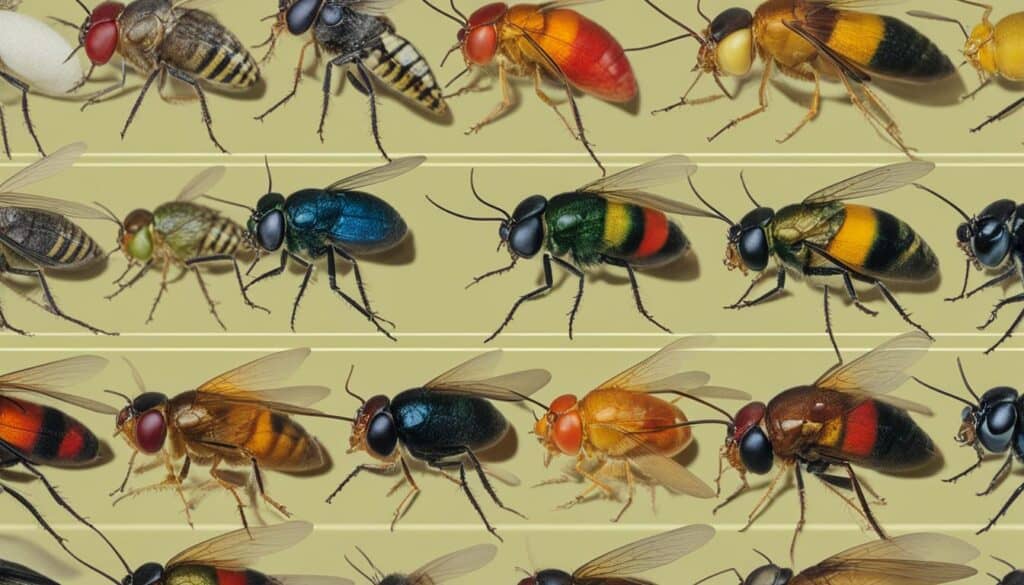
With this newfound knowledge about the impact of environmental factors on fruit fly development, the possibilities for further research and experimentation are endless. Exploring how these factors interact and influence each other can lead to groundbreaking discoveries and advancements in various scientific fields.
Exploring Fruit Fly Sensory Perception and Responses
Fruit flies possess remarkable sensory perception, enabling us to design experiments that delve into their responses to various stimuli. By investigating how fruit flies react to odors, sounds, and visual cues, we can gain insights into their behavioral responses and understand how they perceive and interact with their environment.
Uncovering the World of Fruit Fly Senses
Fruit flies rely on their senses to navigate their surroundings and locate food sources. Through creative fruit fly experiments, we can explore their sensory abilities and discover intriguing aspects of their behavior.
“The sensory responses of fruit flies offer a fascinating window into their perception of the world.”
Odor Perception
Fruit flies have a highly developed sense of smell, making them expert navigators in search of ripe fruit and other food sources. By exposing fruit flies to different scents, we can observe their responses and discern their preferences. This knowledge can help us understand the role of olfaction in their behavior and potentially develop novel methods of fruit fly control.
Sound Perception
While fruit flies do not possess ears like humans, they can sense and respond to sound vibrations. By subjecting fruit flies to varying sound frequencies and volumes, we can investigate their auditory capabilities and observe changes in their behavior. These experiments allow us to explore the impact of sound on fruit fly communication and mating patterns.
Visual Perception
Fruit flies have compound eyes that enable them to detect and process visual information. By presenting them with different visual cues such as colored lights or patterns, we can study their reactions and gain insights into their visual perception. These experiments help us understand how fruit flies detect predators, identify potential mates, and locate suitable breeding sites.
One captivating experiment involves placing fruit flies in a maze with colored lights at different exits. By observing their choices and navigation patterns, we can determine their sensitivity to visual stimuli and how it influences their decision-making processes.
Analyzing Behavioral Responses
Measuring and analyzing the behavioral responses of fruit flies to various stimuli provide valuable data for understanding their sensory perception. By recording their movements, activity levels, or other observable behaviors, we can quantify and interpret their responses. This information contributes to our knowledge of their sensory systems and enhances our understanding of their complex behaviors.
The Wonders of Fruit Fly Sensory Perception
Exploring fruit fly sensory perception and responses through engaging experiments offers a captivating journey into their remarkable abilities. By studying their reactions to odors, sounds, and visual cues, we gain a deeper understanding of their sensory world and the intricate ways in which they interact with their environment.
Continue reading to discover more fascinating fruit fly experiment ideas!
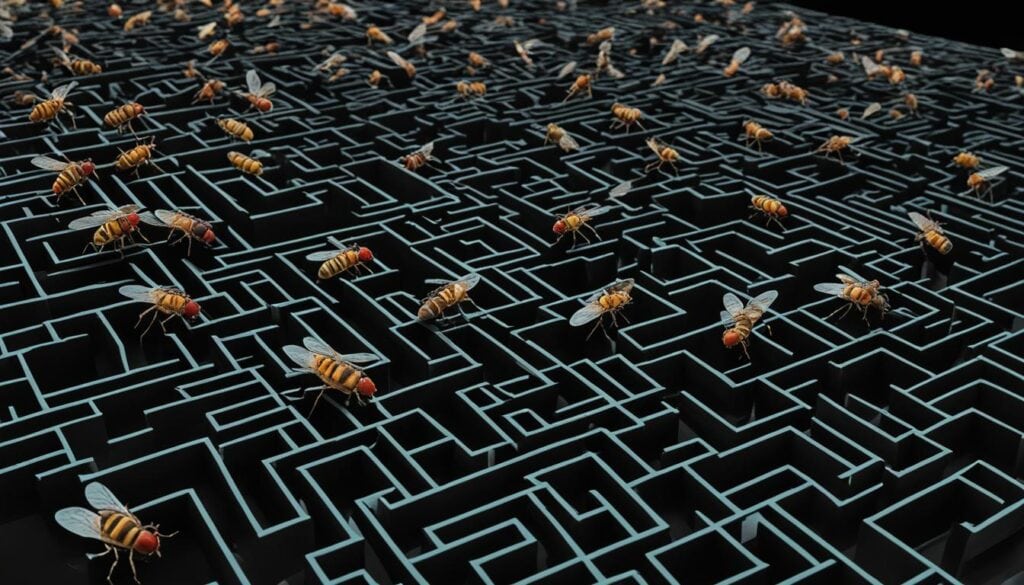
| Fruit Fly Sensory Perception | Experiment Ideas |
|---|---|
| Odor Perception | Create a maze with scented paths to observe fruit fly preference for different odors. |
| Sound Perception | Expose fruit flies to different sound frequencies and volumes to analyze their behavioral responses. |
| Visual Perception | Design experiments using colored lights or patterns to study fruit fly reactions and visual preferences. |
Conclusion
Fruit flies provide a wealth of opportunities for engaging and educational experiments. Whether you’re interested in exploring their genetics, behavior, or responses to environmental factors, these tiny insects offer valuable insights into the world of science. By designing and conducting your own fruit fly experiments, you can not only deepen your understanding of genetics and entomology but also foster a love for scientific inquiry.
So, where do you begin? Start by gathering a few basic materials such as mason jars, fruit, and tape. With these simple tools, you can set up your own fruit fly lab and embark on a fascinating scientific journey. Create experiments to investigate their genetics and inheritance patterns, observe the effects of temperature and diet on their behavior and longevity, or examine how different environmental factors influence their development.
The beauty of fruit fly experiments is their versatility and accessibility. You don’t need a fancy laboratory or expensive equipment to conduct meaningful research. With a curious mind and a spirit of exploration, you can unlock the secrets of these remarkable creatures. So, roll up your sleeves and dive into the world of fruit fly experiment ideas. Who knows what extraordinary discoveries await you!
FAQ
What are some engaging fruit fly experiment ideas for science fans?
Here are some engaging fruit fly experiment ideas that science fans will love.
Why is fruit fly research important in biomedical sciences?
Fruit fly research has provided valuable insights into genetics, gene organization, mutational screenings, and fundamental biological processes. They are excellent models for studying disease mechanisms and finding potential cures.
How can I make fruit fly traps and insect sprays?
If you’re dealing with fruit flies in your house or kitchen, you can make a simple and effective fruit fly trap using a mason jar, paper, tape, and a piece of fruit. There are also natural homemade insect sprays and traps available that can help control fruit flies and other pesky insects without harmful chemicals.
How can I investigate the effects of temperature on fruit fly behavior?
You can design experiments to manipulate the temperature in their environment and observe and analyze the changes in their behavior, such as movement, mating patterns, or feeding habits.
How can I observe fruit fly genetics and inheritance patterns?
You can design experiments to investigate specific genetic traits, such as eye color, wing shape, or body size, and analyze the patterns of inheritance by breeding and observing generations of fruit flies.
How can I explore the effects of different diets on fruit fly lifespan?
You can conduct experiments to explore how different diets, such as sugar, protein, or fat-based diets, impact their lifespan and overall health by monitoring their lifespan and observing any changes in behavior or physical characteristics.
How can I examine the impact of environmental factors on fruit fly development?
You can design experiments to investigate the effects of factors like light exposure, humidity, or air quality on fruit fly development by manipulating these variables and closely monitoring their growth and maturation.
How can I explore fruit fly sensory perception and responses?
You can design experiments to investigate how fruit flies react to odors, sounds, or visual cues and analyze their behavioral responses, gaining insights into how they perceive and interact with their environment.
What are some conclusions about fruit fly experimentation?
Fruit flies provide endless possibilities for engaging and educational experiments in genetics, behavior, and responses to environmental factors. By conducting your own fruit fly experiments, you can gain a deeper understanding of genetics, entomology, and scientific inquiry while having fun in the process.

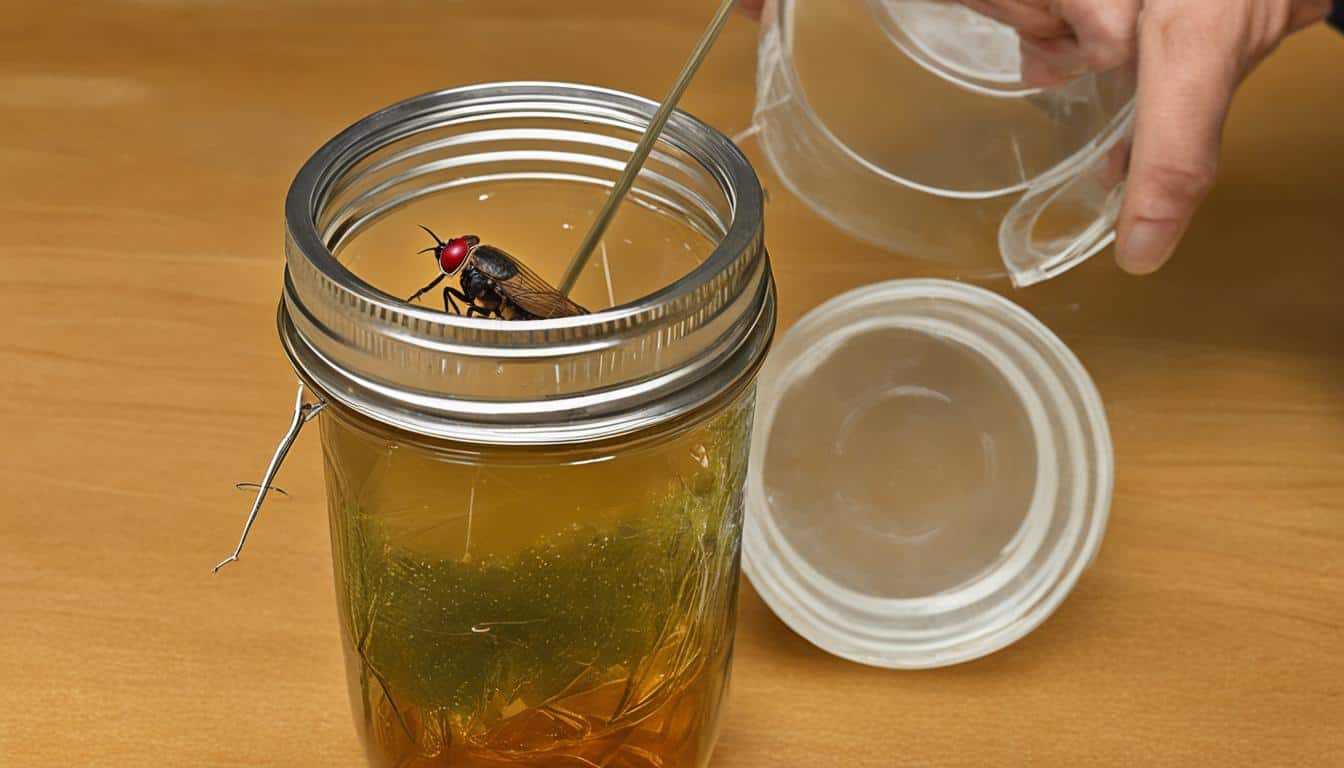

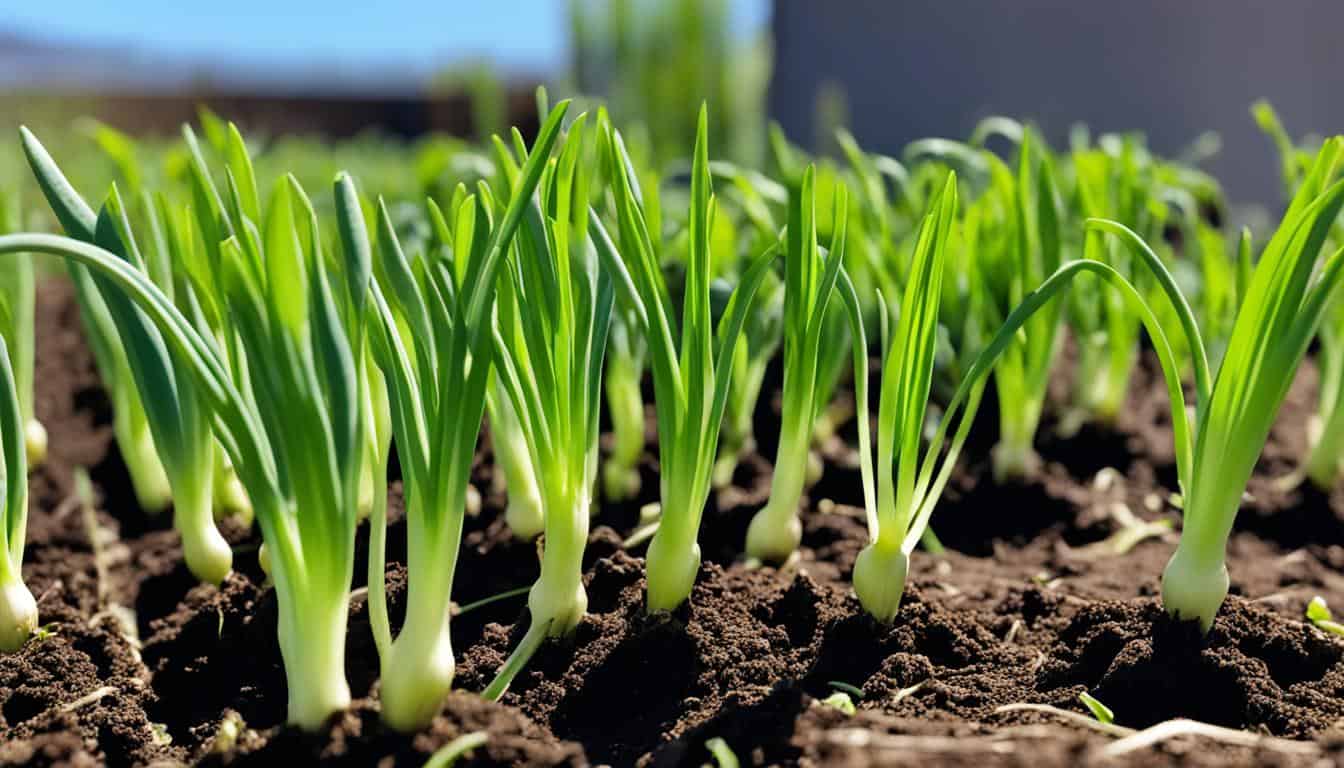
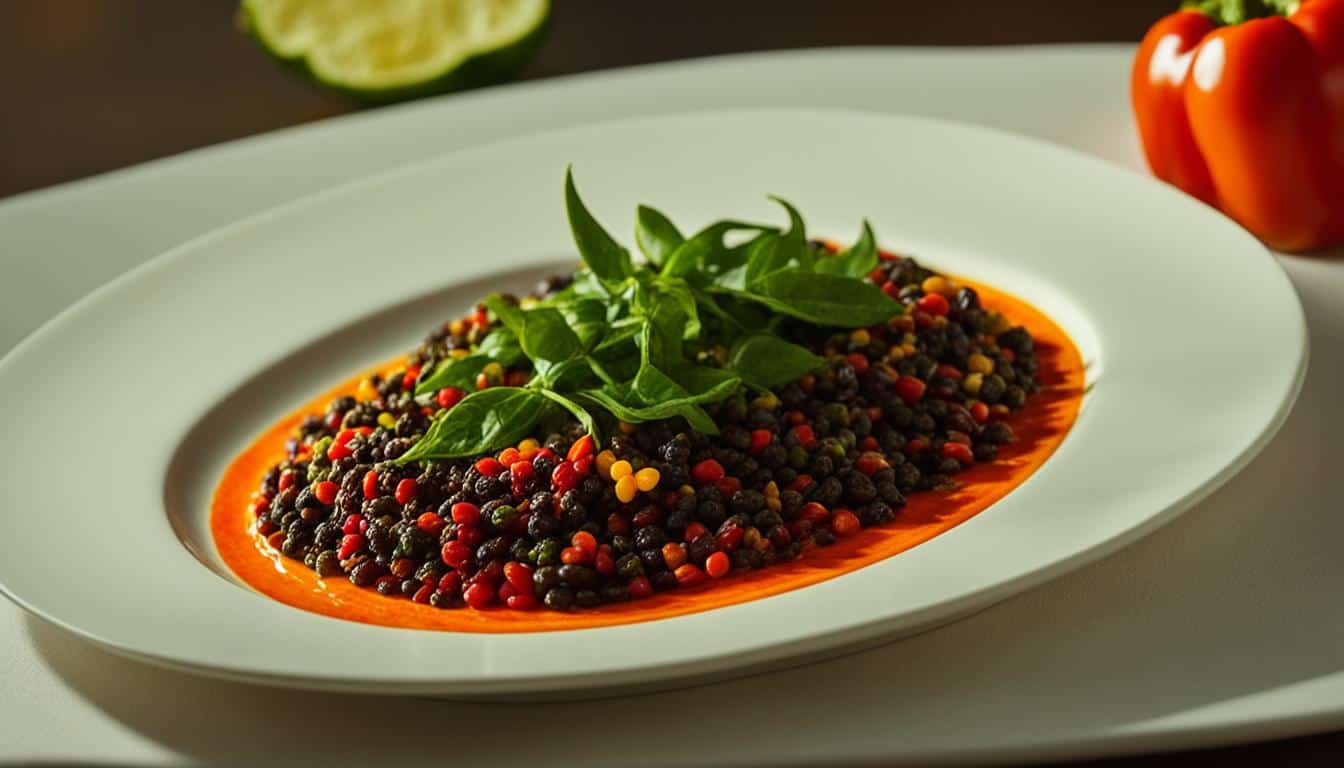
Leave a Reply